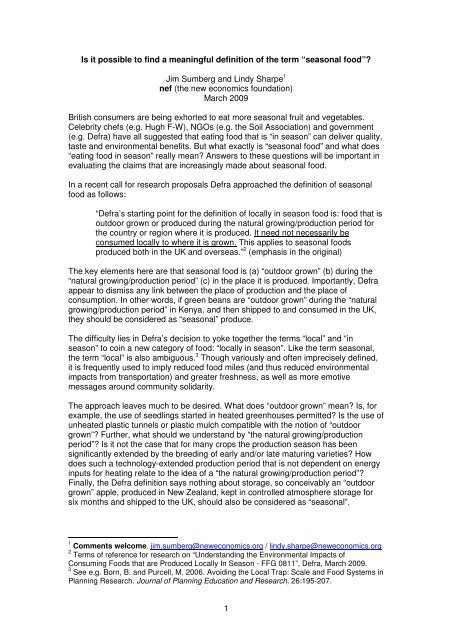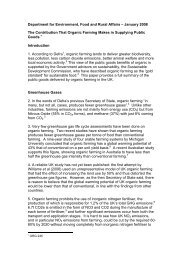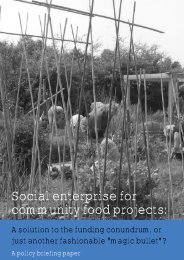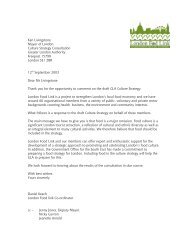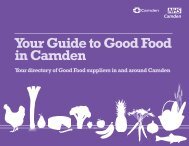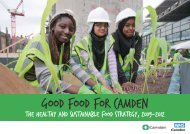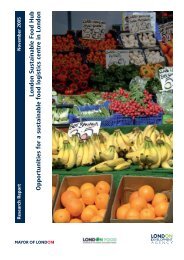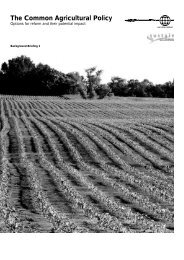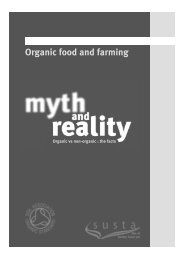“seasonal food”? - Sustain
“seasonal food”? - Sustain
“seasonal food”? - Sustain
You also want an ePaper? Increase the reach of your titles
YUMPU automatically turns print PDFs into web optimized ePapers that Google loves.
Is it possible to find a meaningful definition of the term <strong>“seasonal</strong> <strong>food”</strong>?<br />
Jim Sumberg and Lindy Sharpe 1<br />
nef (the new economics foundation)<br />
March 2009<br />
British consumers are being exhorted to eat more seasonal fruit and vegetables.<br />
Celebrity chefs (e.g. Hugh F-W), NGOs (e.g. the Soil Association) and government<br />
(e.g. Defra) have all suggested that eating food that is “in season” can deliver quality,<br />
taste and environmental benefits. But what exactly is <strong>“seasonal</strong> <strong>food”</strong> and what does<br />
“eating food in season” really mean? Answers to these questions will be important in<br />
evaluating the claims that are increasingly made about seasonal food.<br />
In a recent call for research proposals Defra approached the definition of seasonal<br />
food as follows:<br />
“Defra’s starting point for the definition of locally in season food is: food that is<br />
outdoor grown or produced during the natural growing/production period for<br />
the country or region where it is produced. It need not necessarily be<br />
consumed locally to where it is grown. This applies to seasonal foods<br />
produced both in the UK and overseas.” 2 (emphasis in the original)<br />
The key elements here are that seasonal food is (a) “outdoor grown” (b) during the<br />
“natural growing/production period” (c) in the place it is produced. Importantly, Defra<br />
appear to dismiss any link between the place of production and the place of<br />
consumption. In other words, if green beans are “outdoor grown” during the “natural<br />
growing/production period” in Kenya, and then shipped to and consumed in the UK,<br />
they should be considered as <strong>“seasonal</strong>” produce.<br />
The difficulty lies in Defra’s decision to yoke together the terms “local” and “in<br />
season” to coin a new category of food: “locally in season”. Like the term seasonal,<br />
the term “local” is also ambiguous. 3 Though variously and often imprecisely defined,<br />
it is frequently used to imply reduced food miles (and thus reduced environmental<br />
impacts from transportation) and greater freshness, as well as more emotive<br />
messages around community solidarity.<br />
The approach leaves much to be desired. What does “outdoor grown” mean? Is, for<br />
example, the use of seedlings started in heated greenhouses permitted? Is the use of<br />
unheated plastic tunnels or plastic mulch compatible with the notion of “outdoor<br />
grown”? Further, what should we understand by “the natural growing/production<br />
period”? Is it not the case that for many crops the production season has been<br />
significantly extended by the breeding of early and/or late maturing varieties? How<br />
does such a technology-extended production period that is not dependent on energy<br />
inputs for heating relate to the idea of a “the natural growing/production period”?<br />
Finally, the Defra definition says nothing about storage, so conceivably an “outdoor<br />
grown” apple, produced in New Zealand, kept in controlled atmosphere storage for<br />
six months and shipped to the UK, should also be considered as <strong>“seasonal</strong>”.<br />
1 Comments welcome. jim.sumberg@neweconomics.org / lindy.sharpe@neweconomics.org<br />
2 Terms of reference for research on “Understanding the Environmental Impacts of<br />
Consuming Foods that are Produced Locally In Season - FFG 0811”, Defra, March 2009.<br />
3 See e.g. Born, B. and Purcell, M. 2006. Avoiding the Local Trap: Scale and Food Systems in<br />
Planning Research. Journal of Planning Education and Research, 26:195-207.<br />
1
The reality is that one of the goals and achievements of international retail supply<br />
chains has been to make “local seasonality”, as it moves around the globe, available<br />
to retail customers. This isn’t a new ambition – historic examples include the new<br />
crop carried from China to the UK by tea clippers, le Beaujolais nouveau and truffles<br />
– but modern logistics technology has been specifically developed to make “locally in<br />
season” goods much more accessible and affordable.<br />
Leaving aside for now the much debated question of what constitutes local, are there<br />
other more meaningful ways to think about seasonal food?<br />
There would appear to be three main factors that must be taken into consideration<br />
when defining seasonal food:<br />
1. The degree to which the production environment is altered;<br />
2. The seasonal difference between the sites of production and consumption;<br />
3. The form of food.<br />
Agriculture, by its very nature, is about altering the natural environment. Depending<br />
on the production system, land is cleared and cultivated, nutrients are added, pests<br />
suppressed, irrigation water applied and so on. Some technologies are specifically<br />
designed to manipulate the growing season, by increasing the air temperature (e.g.<br />
through heated or unheated tunnels) and/or the addition of artificial light. Each<br />
system, as a combination of environmental conditions, technology and the genetic<br />
potential of a particular crop variety, results in given production and harvest seasons.<br />
As agriculture developed over the centuries, the production and harvest seasons of<br />
some individual crops changed dramatically.<br />
Seen in this light, the notion of a “natural growing/production period” is highly<br />
problematic. However, given the pressing policy priority of reducing carbon<br />
emissions in the food chain, it would seem reasonable to conclude that produce from<br />
any production system that was dependent on fossil fuels to modify air temperature<br />
and/or light levels should not be considered <strong>“seasonal</strong>”. 4<br />
In addition to issues around production systems, those who stress the quality, taste<br />
and “food culture” aspects of seasonal food are presumably thinking about<br />
seasonality within the area of consumption. Here the basic idea is that during any<br />
particular period or season you orient your consumption to what is produced in your<br />
location (however that is defined). In this sense, the proposition that food imported<br />
from half-way around the globe could be considered <strong>“seasonal</strong>” to somewhere in the<br />
UK is clearly untenable. Moreover, from an environmental perspective, the benefits of<br />
a <strong>“seasonal</strong>” approach to consumption may be largely lost through the carbon<br />
emissions associated with long-distance transportation.<br />
The final factor that we consider is the form of the food when it is purchased by the<br />
consumer: fresh; having been stored; or having been preserved. This addresses the<br />
question of whether all <strong>“seasonal</strong>” food must be “fresh” (consumed shortly after being<br />
harvested): are “new” potatoes produced near the point of consumption <strong>“seasonal</strong>” in<br />
the same way as potatoes from the same farm that have spent five months in<br />
storage? Our sense is that from an environmental perspective the answer to this<br />
question should depend on the type or energy intensity of the storage technology.<br />
4 We are leaving open here the question of whether produce from a production system that<br />
used renewable energy to modify air temperature and or light levels could be considered<br />
<strong>“seasonal</strong>”.<br />
2
Similarly, it is difficult to see how preserved or processed foods could ever be<br />
<strong>“seasonal</strong>”.<br />
We summarise these factors in the table below. Our suggestion is that in order to be<br />
considered as a <strong>“seasonal</strong>” food a product must meet the following criteria:<br />
Production system = 1, plus Seasonal difference = A, plus Form of consumption = a<br />
or b.<br />
Production system<br />
1. Fossil fuels not used to alter air temperature and/or light levels<br />
2. Fossil fuels used to alter sir temperature and/or light levels<br />
Seasonal difference between areas of production & consumption<br />
A. None – small<br />
B. Large<br />
Form of consumption 5<br />
a. Fresh (10 days post-harvest; low energy storage)<br />
c. Stored 2 (>10 days post-harvest; high energy storage)<br />
d. Preserved<br />
In conclusion, we applaud Defra for attempting to pin down a notion that lies at the<br />
heart of contestation amid the commercial imperatives of contemporary food supply<br />
chains, consumer expectations of the food supply, and the need to reduce food chain<br />
GHG emissions. The use, by government, NGOs, the food industry and food<br />
consumers, of emotive but imprecisely defined terms such as “local” and <strong>“seasonal</strong>”<br />
obscures the issues underlying this conflict, and clearer definitions are urgently<br />
needed. However, the definition offered of “locally in season <strong>food”</strong>, by harnessing<br />
ideas which are both inherently ambiguous and mutually contradictory, is of limited<br />
value in this regard.<br />
5 The 10-day limits are entirely arbitrary and for illustration purposes only.<br />
3


